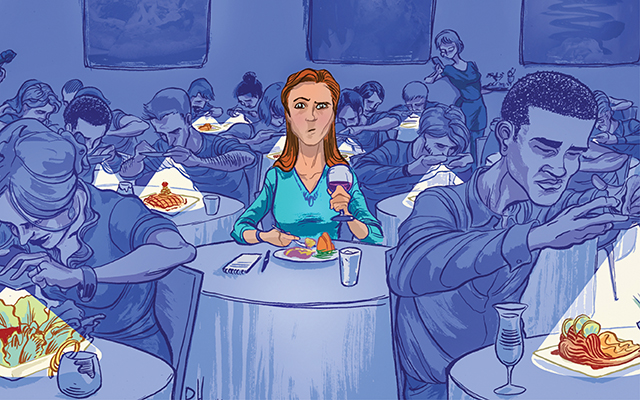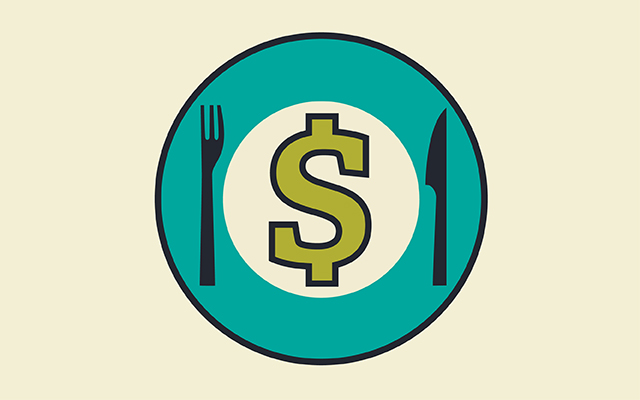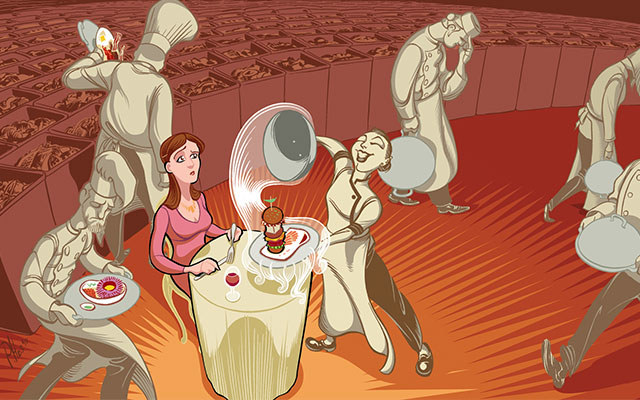In the 1980s, parsley sprinkled randomly onto a white plate signaled fine dining. Today, it’s Bull’s Blood beet microgreens. These delicate crimson-and-sage beauties taste like all sprouts everywhere: of nothing and of iron, at once.
You know you’ve arrived when you find yourself at an establishment where your server presents you with a salad or a piece of toast piled with multihued greenery resembling a miniature bird’s nest. “Dear Diary: Nothing much happened today, but there were Bull’s Blood beet microgreens all over the ginger-buttercup cubes on the green swoosh, so I must be doing all right.”
Food trends come and go, and while I admit some ambivalence toward the microgreens du jour, they’re not quite as confounding as some other culinary fads.
Recently, in a fancy restaurant — the kind of place where you can find an open table only at 9 o’clock on a weeknight — I was served (with a microgreens garnish) a mushroomy broth of ambiguous temperature. It wasn’t hot, and yet it wasn’t cold. When I inquired about the chef’s intent, the server pivoted in place to ask the cook in the open kitchen a few feet away. “It’s supposed to be whatever temperature,” he responded. “People don’t like hot soup anymore.”
My head exploded and all life became a blur. People don’t like hot soup? Which people? People whose ancestors spent centuries eating out of cauldrons suspended over smoldering hearth fires?
I know from observing many a cooking competition that insufficient attention to temperature will disqualify a chef every time. This cook had apparently never participated in a cooking competition — but I’m guessing he’s spent a great many hours tracking food trends on Instagram.
Food for the People
Oh, Instagram! How the social-media platform has transformed food and food culture. If you don’t know Instagram, I’ll fill you in: It’s basically a visual highlight reel, a photographic journal in which everybody’s days are good and the food is always attractive and delicious.
There’s so much #food. If you search #food, you’ll find more than 253 million such posts. #Foodporn, 145 million. #Delicious, 72 million. #Yum, 65 million. You get the idea.
This is the no-cost, no-criticism platform of every restaurateur’s dreams. For eaters, Instagram is the warm bath you can retreat to when the Twitter wars get too hot or the Facebook opinions too tedious.
Instagram has changed everything in the foodie world. It has transformed dishware: Plates must now be textured and rough, to make the food’s visual frame more appealing. It has transformed the dining room: The chic, modern salle à manger must now feature a small pinpoint light over the middle of the table, the better to provide a jeweler’s spotlight on the tuna. The table and wall surfaces must be matte, to better diffuse the glare of the phone-camera flash.
Selfie-perfect murals are suddenly in all the new restaurants. Desserts fan out 10 inches this way and 6 that way in a flurry of crumbs, the better to reach the edge of the photographer’s frame. (Interestingly, there’s a chef-led Instagram backlash in some circles, in which cooks deliberately obscure food from view — adding a meringue lid over the dessert, for instance. But then again, that’s ideal for the two-frame, before-and-after shot.)
And Then It Gets Weird
Perhaps more disturbing to me than room-temperature soup, however, is the food-coloring trend that has swept upon Instagram like a chromatic tsunami.
There are #rainbowbagels — 10,000 posts featuring bagels made by subdividing the dough, tinting it, and then reforming it so that the baked bagel boasts colorful stripes. There’s a phenomenon variously termed Mermaid Toast and Unicorn Toast featuring cream cheese and sprinkles, dehydrated vegetable powders, and food coloring. There are #glitter and #sparkle cookies, milkshakes, and cocktails — you name it.
Companies want to get in on this action, of course, which is why Starbucks unveiled something called the Unicorn Frappuccino last spring, which looked so . . . cute. It was pink as a flamingo, blue as a cartoon sky, and topped with glittery, multicolored whipped cream.
Thinking it a harmless gag, I bought a small Unicorn Frappuccino on the day it was introduced and sampled the beverage on a live radio show. I had four or five sips and endured a headache for the next 36 hours. As I kneaded my temples in agony, I recalled that many of the food-coloring additives used routinely in American foods are banned in Europe — because folks there believe they’re, well, harmful. They were certainly harmful to me.
As a food professional of long standing, I will give you my complex and nuanced opinion: Fancy coffee drinks are good; glittery fancy coffee drinks are bad.
Instagram Inspiration
All of this is not to say that Instagram-worthy food is without benefit. Another major trend on the platform is #healthy (with 111 million posts) and its various subthreads, including #kale, #avocado, and #quinoa.
Why are so many people Instagramming their kale bowls and avocado salads? You could call it virtue signaling, or you could call it inspiration and motivation. Whatever the reason, it’s transformed the lunch environment of the downtown where I work. The standard office worker who once dined on grilled cheese and black coffee now enjoys a bowl of salad heaped with high-nutrition add-ins, such as seeds and grains and roasted root vegetables, as prepared by chains such as Sweetgreen, Chopt, or Just Salad.
I’m all for this trend. I think Instagram’s #healthy channels are passing along veritable volumes of good-food knowledge. People are learning about different ingredients and gaining an alternative perspective on wholesome fare, such as vegetables. Remember the food pyramid? It has been replaced by an Instagram-worthy circle — the bowl or plate — and the main ingredients are green.
Like any other newfangled fad, Instagram comes with benefits and challenges. I have just one thing to ask of photo foodies as they embrace the visual elements of their cuisine: Don’t forget that history, culture, flavor, and texture are important, too.
And that hot soup really is much better served hot.
This originally appeared as “Beauty Is in the Eye of the Camera” in the March 2018 print issue of Experience Life.




This Post Has 0 Comments